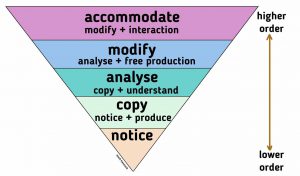
In my last post, article 2 in this series, I suggested that pronunciation teaching post-ELF must distinguish productive and receptive competences, and these will be asymmetrical.
In an English-as-a-lingua-franca speech community, we will pronounce locally and understand globally. The accent or range of accents we can produce will be much smaller than the range of accents we are capable of understanding.
We teachers will have to recognise that our learners’ pronunciation skills will need to be interactive, because communication is a two-way street. The capacity to adapt to an interlocutor – known as ‘accommodation’ – will take its place as the highest order in a hierarchy of pronunciation skills. This hierarchy could perhaps be represented in a similar way to Bloom’s well-known hierarchy of thinking skills, as in this diagram.

In this diagram, each higher layer includes the layer below it and adds something – it is incremental. From lower to higher: The learner …
- notices a pronunciation feature.
- tries to copy what they have noticed.
- tries to understand the patterns in what they are copying.
- tries to apply that understanding in order to modify their own speech.
- modifies their own speech and accommodates to the speech of their interlocutors.
The higher up in this hierarchy that the learner is able to reach, the better they will be equipped to take their place in a global speech community in which English is a principal lingua franca.
This perspective on pronunciation skills will have a range of implications for teaching:
- Many traditional materials and practices will remain appropriate.
- Others may need to be modified in some ways – most notably, in the way we give feedback during the activity.
- Some will still be of value, but possibly only for receptive purposes rather than productive.
- Finally, there will be a need for some new materials and practices to be added to our repertoire.
I will investigate the above implications for teaching further in posts to follow.

